Assessment of Artificial Neural Network through Drought Indices
Abstract
:1. Introduction
- Computation of PET and drought indices (SPEI and SPI) using high resolution gridded data.
- ANN model development and prediction of PET.
- Computation and comparison of ANN–based PET with the observed data–based PET for various drought indices.
2. Materials and Methods
2.1. Data Acquisition
2.2. Methodology
3. Results and Discussion
3.1. Penman–Monteith and ANN–Based PET
3.2. SPI and SPEI with Penman–Monteith and ANN–Based PET
4. Conclusions
- ANN–based PET shows a lower values than Penman–Monteith–based PET for maximum values and a higher values for minimum values. Location and time are similar.
- SPI shows a higher values in moist and drought conditions than SPEI.
- Severity classification changes during drought conditions for SPEI computed by ANN for 1–month duration, but the class remains the same for 3, 6, 9, and 12–months duration.
- Lag is seen in moist and drought conditions in SPEI computed using ANN.
Supplementary Materials
Author Contributions
Funding
Institutional Review Board Statement
Informed Consent Statement
Data Availability Statement
Conflicts of Interest
References
- Connor, R. The United Nations World Water Development Report 2015: Water for a Sustainable World; UNESCO Publishing: Paris, France, 2015; Volume 1, ISBN 9231000713. [Google Scholar]
- Fischer, G.; Tubiello, F.N.; Van Velthuizen, H.; Wiberg, D.A. Climate Change Impacts on Irrigation Water Requirements: Effects of Mitigation, 1990–2080. Technol. Forecast. Soc. Chang. 2007, 74, 1083–1107. [Google Scholar] [CrossRef]
- Poddar, A.; Gupta, P.; Kumar, N.; Shankar, V.; Ojha, C.S.P. Evaluation of Reference Evapotranspiration Methods and Sensitivity Analysis of Climatic Parameters for Sub–Humid Sub–Tropical Locations in Western Himalayas (India). ISH J. Hydraul. Eng. 2021, 27, 336–346. [Google Scholar] [CrossRef]
- Gleeson, T.; Wada, Y.; Bierkens, M.F.P.; Van Beek, L.P.H. Water Balance of Global Aquifers Revealed by Groundwater Footprint. Nature 2012, 488, 197–200. [Google Scholar] [CrossRef]
- Hameed, M.; Ahmadalipour, A.; Moradkhani, H. Drought and Food Security in the Middle East: An Analytical Framework. Agric. For. Meteorol. 2020, 281, 107816. [Google Scholar] [CrossRef]
- Van Loon, A.F.; Stahl, K.; Di Baldassarre, G.; Clark, J.; Rangecroft, S.; Wanders, N.; Gleeson, T.; Van Dijk, A.I.J.M.; Tallaksen, L.M.; Hannaford, J. Drought in a Human–Modified World: Reframing Drought Definitions, Understanding, and Analysis Approaches. Hydrol. Earth Syst. Sci. 2016, 20, 3631–3650. [Google Scholar] [CrossRef]
- Dai, A. Increasing Drought under Global Warming in Observations and Models. Nat. Clim. Chang. 2013, 3, 52–58. [Google Scholar] [CrossRef]
- Naumann, G.; Alfieri, L.; Wyser, K.; Mentaschi, L.; Betts, R.A.; Carrao, H.; Spinoni, J.; Vogt, J.; Feyen, L. Global Changes in Drought Conditions under Different Levels of Warming. Geophys. Res. Lett. 2018, 45, 3285–3296. [Google Scholar] [CrossRef]
- Zhou, J.; Wang, Y.; Su, B.; Wang, A.; Tao, H.; Zhai, J.; Kundzewicz, Z.W.; Jiang, T. Choice of Potential Evapotranspiration Formulas Influences Drought Assessment: A Case Study in China. Atmos. Res. 2020, 242, 104979. [Google Scholar] [CrossRef]
- Granata, F.; Di Nunno, F. Forecasting Evapotranspiration in Different Climates Using Ensembles of Recurrent Neural Networks. Agric. Water Manag. 2021, 255, 107040. [Google Scholar] [CrossRef]
- Paulson, R.W.; Chase, E.B.; Roberts, R.S.; Moody, D.W. National Water Summary 1988–89—Hydrologic Events and Floods and Droughts; US Government Printing Office: Reston, VA, USA, 1991. [Google Scholar]
- Mavi, H.S.; Tupper, G.J. Agrometeorology: Principles and Applications of Climate Studies in Agriculture; CRC Press: Boca Raton, FL, USA, 2004; ISBN 0429078374. [Google Scholar]
- Allen, R.G.; Pereira, L.S.; Raes, D.; Smith, M. Crop Evapotranspiration–Guidelines for Computing Crop Water Requirements–FAO Irrigation and Drainage Paper 56; FAO: Rome, Italy, 1998; Volume 300, p. D05109. [Google Scholar]
- Sentelhas, P.C.; Gillespie, T.J.; Santos, E.A. Evaluation of FAO Penman–Monteith and Alternative Methods for Estimating Reference Evapotranspiration with Missing Data in Southern Ontario, Canada. Agric. Water Manag. 2010, 97, 635–644. [Google Scholar] [CrossRef]
- Blyth, E.M.; Martínez–de la Torre, A.; Robinson, E.L. Trends in Evapotranspiration and Its Drivers in Great Britain: 1961 to 2015. Prog. Phys. Geogr. 2019, 43, 666–693. [Google Scholar] [CrossRef]
- Kumar, M.; Raghuwanshi, N.S.; Singh, R. Artificial Neural Networks Approach in Evapotranspiration Modeling: A Review. Irrig. Sci. 2011, 29, 11–25. [Google Scholar] [CrossRef]
- Paparrizos, S.; Maris, F.; Matzarakis, A. Sensitivity Analysis and Comparison of Various Potential Evapotranspiration Formulae for Selected Greek Areas with Different Climate Conditions. Theor. Appl. Climatol. 2017, 128, 745–759. [Google Scholar] [CrossRef]
- George, B.A.; Reddy, B.R.S.; Raghuwanshi, N.S.; Wallender, W.W. Decision Support System for Estimating Reference Evapotranspiration. J. Irrig. Drain. Eng. 2002, 128, 1–10. [Google Scholar] [CrossRef]
- Xu, C.; Singh, V.P. Evaluation and Generalization of Radiation-based Methods for Calculating Evaporation. Hydrol. Process. 2000, 14, 339–349. [Google Scholar] [CrossRef]
- Lu, J.; Sun, G.; McNulty, S.G.; Amatya, D.M. A Comparison of Six Potential Evapotranspiration Methods for Regional Use in the Southeastern United States 1. JAWRA J. Am. Water Resour. Assoc. 2005, 41, 621–633. [Google Scholar] [CrossRef]
- Nandagiri, L.; Kovoor, G.M. Performance Evaluation of Reference Evapotranspiration Equations across a Range of Indian Climates. J. Irrig. Drain. Eng. 2006, 132, 238–249. [Google Scholar] [CrossRef]
- Kashyap, P.S.; Panda, R.K. Evaluation of Evapotranspiration Estimation Methods and Development of Crop–Coefficients for Potato Crop in a Sub–Humid Region. Agric. Water Manag. 2001, 50, 9–25. [Google Scholar] [CrossRef]
- Irmak, S.; Allen, R.G.; Whitty, E.B. Daily Grass and Alfalfa–Reference Evapotranspiration Estimates and Alfalfa–to–Grass Evapotranspiration Ratios in Florida. J. Irrig. Drain. Eng. 2003, 129, 360–370. [Google Scholar] [CrossRef]
- Itenfisu, D.; Elliott, R.L.; Allen, R.G.; Walter, I.A. Comparison of Reference Evapotranspiration Calculations as Part of the ASCE Standardization Effort. J. Irrig. Drain. Eng. 2003, 129, 440–448. [Google Scholar] [CrossRef]
- Cai, J.; Liu, Y.; Lei, T.; Pereira, L.S. Estimating Reference Evapotranspiration with the FAO Penman–Monteith Equation Using Daily Weather Forecast Messages. Agric. For. Meteorol. 2007, 145, 22–35. [Google Scholar] [CrossRef]
- Alexandris, S.; Kerkides, P.; Liakatas, A. Daily Reference Evapotranspiration Estimates by the “Copais” Approach. Agric. Water Manag. 2006, 82, 371–386. [Google Scholar] [CrossRef]
- Saxton, K.E. Sensitivity Analyses of the Combination Evapotranspiration Equation. Agric. Meteorol. 1975, 15, 343–353. [Google Scholar] [CrossRef]
- Beven, K. A Sensitivity Analysis of the Penman–Monteith Actual Evapotranspiration Estimates. J. Hydrol. 1979, 44, 169–190. [Google Scholar] [CrossRef]
- Mishra, A.K.; Singh, V.P. A Review of Drought Concepts. J. Hydrol. 2010, 391, 202–216. [Google Scholar] [CrossRef]
- Westerling, A.L.; Hidalgo, H.G.; Cayan, D.R.; Swetnam, T.W. Warming and Earlier Spring Increase Western US Forest Wildfire Activity. Science 2006, 313, 940–943. [Google Scholar] [CrossRef] [PubMed]
- Pedro–Monzonís, M.; Solera, A.; Ferrer, J.; Estrela, T.; Paredes–Arquiola, J. A Review of Water Scarcity and Drought Indexes in Water Resources Planning and Management. J. Hydrol. 2015, 527, 482–493. [Google Scholar] [CrossRef]
- Lesk, C.; Rowhani, P.; Ramankutty, N. Influence of Extreme Weather Disasters on Global Crop Production. Nature 2016, 529, 84–87. [Google Scholar] [CrossRef]
- Alary, V.; Messad, S.; Aboul–Naga, A.; Osman, M.A.; Daoud, I.; Bonnet, P.; Juanes, X.; Tourrand, J.F. Livelihood Strategies and the Role of Livestock in the Processes of Adaptation to Drought in the Coastal Zone of Western Desert (Egypt). Agric. Syst. 2014, 128, 44–54. [Google Scholar] [CrossRef]
- Cheeseman, J. Food Security in the Face of Salinity, Drought, Climate Change, and Population Growth. In Halophytes for Food Security in Dry Lands; khan, M.A., Ozturk, M., Gul, B., Ahmed, M.Z., Eds.; Academic Press: San Diego, CA, USA, 2016; pp. 111–123. ISBN 978-0-12-801854-5. [Google Scholar]
- Clark, J.S.; Iverson, L.; Woodall, C.W.; Allen, C.D.; Bell, D.M.; Bragg, D.C.; D’Amato, A.W.; Davis, F.W.; Hersh, M.H.; Ibanez, I. The Impacts of Increasing Drought on Forest Dynamics, Structure, and Biodiversity in the United States. Glob. Chang. Biol. 2016, 22, 2329–2352. [Google Scholar] [CrossRef]
- Stanke, C.; Kerac, M.; Prudhomme, C.; Medlock, J.; Murray, V. Health Effects of Drought: A Systematic Review of the Evidence. PLoS Curr. 2013, 5. [Google Scholar] [CrossRef] [PubMed]
- Lloyd–Hughes, B. The Impracticality of a Universal Drought Definition. Theor. Appl. Climatol. 2014, 117, 607–611. [Google Scholar] [CrossRef]
- Wilhite, D.A. Chapter 1 Drought as a Natural Hazard: Concepts and Definitions Drought as a Natural Hazard: Concepts and Definitions. Drought A Glob. Assessment, Drought Mitig. Cent. Fac. Publ. Pap. 69. 2000. Available online: https://digitalcommons.unl.edu/droughtfacpub/69/ (accessed on 25 October 2022).
- Hayes, M.J.; Svoboda, M.D.; Wardlow, B.D.; Anderson, M.C.; Kogan, F. Drought Mitigation Center Faculty Publications: 2012. Drought Monitoring: Historical and Current Perspectives. Available online: https://digitalcommons.unl.edu/droughtfacpub/94/ (accessed on 25 October 2022).
- Trenberth, K.E.; Dai, A.; Van Der Schrier, G.; Jones, P.D.; Barichivich, J.; Briffa, K.R.; Sheffield, J. Global Warming and Changes in Drought. Nat. Clim. Chang. 2014, 4, 17–22. [Google Scholar] [CrossRef]
- Dai, A. Drought under Global Warming: A Review. Wiley Interdiscip. Rev. Clim. Chang. 2011, 2, 45–65. [Google Scholar] [CrossRef]
- Mukherjee, S.; Mishra, A.; Trenberth, K.E. Climate Change and Drought: A Perspective on Drought Indices. Curr. Clim. Chang. Reports 2018, 4, 145–163. [Google Scholar] [CrossRef]
- Stagge, J.H.; Tallaksen, L.M.; Gudmundsson, L.; Van Loon, A.F.; Stahl, K. Candidate Distributions for Climatological Drought Indices (SPI and SPEI). Int. J. Climatol. 2015, 35, 4027–4040. [Google Scholar] [CrossRef]
- Hayes, M.J.; Svoboda, M.D.; Wiihite, D.A.; Vanyarkho, O.V. Monitoring the 1996 Drought Using the Standardized Precipitation Index. Bull. Am. Meteorol. Soc. 1999, 80, 429–438. [Google Scholar] [CrossRef]
- Brázdil, R.; Trnka, M.; Dobrovolný, P.; Chromá, K.; Hlavinka, P.; Žalud, Z. Variability of Droughts in the Czech Republic, 1881–2006. Theor. Appl. Climatol. 2009, 97, 297–315. [Google Scholar] [CrossRef]
- Paulo, A.A.; Rosa, R.D.; Pereira, L.S. Climate Trends and Behaviour of Drought Indices Based on Precipitation and Evapotranspiration in Portugal. Nat. Hazards Earth Syst. Sci. 2012, 12, 1481–1491. [Google Scholar] [CrossRef]
- Capra, A.; Scicolone, B. Spatiotemporal Variability of Drought on a Short–Medium Time Scale in the Calabria Region (Southern Italy). Theor. Appl. Climatol. 2012, 110, 471–488. [Google Scholar] [CrossRef]
- Um, M.-J.; Kim, Y.; Park, D.; Kim, J. Effects of Different Reference Periods on Drought Index (SPEI) Estimations from 1901 to 2014. Hydrol. Earth Syst. Sci. 2017, 21, 4989–5007. [Google Scholar] [CrossRef]
- Li, L.; She, D.; Zheng, H.; Lin, P.; Yang, Z.-L. Elucidating Diverse Drought Characteristics from Two Meteorological Drought Indices (SPI and SPEI) in China. J. Hydrometeorol. 2020, 21, 1513–1530. [Google Scholar] [CrossRef]
- Labudová, L.; Labuda, M.; Takáč, J. Comparison of SPI and SPEI Applicability for Drought Impact Assessment on Crop Production in the Danubian Lowland and the East Slovakian Lowland. Theor. Appl. Climatol. 2017, 128, 491–506. [Google Scholar] [CrossRef]
- Kumar, M.; Raghuwanshi, N.S.; Singh, R.; Wallender, W.W.; Pruitt, W.O. Estimating Evapotranspiration Using Artificial Neural Network. J. Irrig. Drain. Eng. 2002, 128, 224–233. [Google Scholar] [CrossRef]
- Zanetti, S.S.; Sousa, E.F.; Oliveira, V.P.; Almeida, F.T.; Bernardo, S. Estimating Evapotranspiration Using Artificial Neural Network and Minimum Climatological Data. J. Irrig. Drain. Eng. 2007, 133, 83–89. [Google Scholar] [CrossRef]
- Cuxart, J.; Verhoef, A.; Marthews, T.R.; Evans, J. Current Challenges in Evapotranspiration Determination, GEWEX News, Quarterly 29. 2019. Available online: https://hal.archives-ouvertes.fr/hal-02901795/ (accessed on 27 October 2022).
- Sudheer, K.P.; Gosain, A.K.; Ramasastri, K.S. Estimating Actual Evapotranspiration from Limited Climatic Data Using Neural Computing Technique. J. Irrig. Drain. Eng. 2003, 129, 214–218. [Google Scholar] [CrossRef]
- Odhiambo, L.O.; Yoder, R.E.; Yoder, D.C.; Hines, J.W. Optimization of Fuzzy Evapotranspiration Model through Neural Training with Input–Output Examples. Trans. ASAE 2001, 44, 1625. [Google Scholar] [CrossRef]
- Trajkovic, S.; Todorovic, B.; Stankovic, M. Forecasting of Reference Evapotranspiration by Artificial Neural Networks. J. Irrig. Drain. Eng. 2003, 129, 454–457. [Google Scholar] [CrossRef]
- Arca, B.; Beniscasa, F.; Vincenzi, M. Evaluation of Neural Network Techniques for Estimating Evapotranspiration. In National Research Council-Research Institute for the:Monitoring of Agroecosystems (IMAes); World Meteorological Organization: Geneva, Switzerland, 2004; pp. 62–97. [Google Scholar]
- Amatya, D.M.; Muwamba, A.; Panda, S.; Callahan, T.; Harder, S.; Pellett, C.A. Assessment of Spatial and Temporal Variation of Potential Evapotranspiration Estimated by Four Methods for South Carolina. J. South Carol. Water Resour. 2018, 5, 5. [Google Scholar] [CrossRef]
- Ahmadipour, A.; Shaibani, P.; Mostafavi, S.A. Assessment of Empirical Methods for Estimating Potential Evapotranspiration in Zabol Synoptic Station by REF–ET Model. Medbiotech J. 2019, 3, 1–4. [Google Scholar]
- Gharbia, S.S.; Smullen, T.; Gill, L.; Johnston, P.; Pilla, F. Spatially Distributed Potential Evapotranspiration Modeling and Climate Projections. Sci. Total Environ. 2018, 633, 571–592. [Google Scholar] [CrossRef] [PubMed]
- Yang, Y.; Chen, R.; Han, C.; Liu, Z. Evaluation of 18 Models for Calculating Potential Evapotranspiration in Different Climatic Zones of China. Agric. Water Manag. 2021, 244, 106545. [Google Scholar] [CrossRef]
- Chia, M.Y.; Huang, Y.F.; Koo, C.H.; Fung, K.F. Recent Advances in Evapotranspiration Estimation Using Artificial Intelligence Approaches with a Focus on Hybridization Techniques—A Review. Agronomy 2020, 10, 101. [Google Scholar] [CrossRef]
- Fan, J.; Yue, W.; Wu, L.; Zhang, F.; Cai, H.; Wang, X.; Lu, X.; Xiang, Y. Evaluation of SVM, ELM and Four Tree–Based Ensemble Models for Predicting Daily Reference Evapotranspiration Using Limited Meteorological Data in Different Climates of China. Agric. For. Meteorol. 2018, 263, 225–241. [Google Scholar] [CrossRef]
- Başağaoğlu, H.; Chakraborty, D.; Winterle, J. Reliable Evapotranspiration Predictions with a Probabilistic Machine Learning Framework. Water 2021, 13, 557. [Google Scholar] [CrossRef]
- Mobilia, M.; Longobardi, A. Prediction of Potential and Actual Evapotranspiration Fluxes Using Six Meteorological Data–Based Approaches for a Range of Climate and Land Cover Types. ISPRS Int. J. Geo–Inf. 2021, 10, 192. [Google Scholar] [CrossRef]
- Ye, L.; Zahra, M.M.A.; Al-Bedyry, N.K.; Yaseen, Z.M. Daily Scale Evapotranspiration Prediction over the Coastal Region of Southwest Bangladesh: New Development of Artificial Intelligence Model. Stoch. Environ. Res. Risk Assess. 2022, 36, 451–471. [Google Scholar] [CrossRef]
- Abedi–Koupai, J.; Dorafshan, M.-M.; Javadi, A.; Ostad-Ali-Askari, K. Estimating Potential Reference Evapotranspiration Using Time Series Models (Case Study: Synoptic Station of Tabriz in Northwestern Iran). Appl. Water Sci. 2022, 12, 1–8. [Google Scholar] [CrossRef]
- PATIL, R.; Nagaraj, D.M.; Polisgowdar, B.S.; RATHOD, S. Forecasting Potential Evapotranspiration for Raichur District Using Seasonal ARIMA Model. Mausam 2022, 73, 433–440. [Google Scholar] [CrossRef]
- Majhi, B.; Naidu, D.; Mishra, A.P.; Satapathy, S.C. Improved Prediction of Daily Pan Evaporation Using Deep–LSTM Model. Neural Comput. Appl. 2020, 32, 7823–7838. [Google Scholar] [CrossRef]
- Salam, R.; Islam, A.R.M.T. Potential of RT, Bagging and RS Ensemble Learning Algorithms for Reference Evapotranspiration Prediction Using Climatic Data–Limited Humid Region in Bangladesh. J. Hydrol. 2020, 590, 125241. [Google Scholar] [CrossRef]
- Wang, G.; Gong, T.; Lu, J.; Lou, D.; Hagan, D.F.T.; Chen, T. On the Long-term Changes of Drought over China (1948–2012) from Different Methods of Potential Evapotranspiration Estimations. Int. J. Climatol. 2018, 38, 2954–2966. [Google Scholar] [CrossRef]
- Um, M.-J.; Kim, Y.; Park, D.; Jung, K.; Wang, Z.; Kim, M.M.; Shin, H. Impacts of Potential Evapotranspiration on Drought Phenomena in Different Regions and Climate Zones. Sci. Total Environ. 2020, 703, 135590. [Google Scholar] [CrossRef] [PubMed]
- Khan, N.; Sachindra, D.A.; Shahid, S.; Ahmed, K.; Shiru, M.S.; Nawaz, N. Prediction of Droughts over Pakistan Using Machine Learning Algorithms. Adv. Water Resour. 2020, 139, 103562. [Google Scholar] [CrossRef]
- Tufaner, F.; Özbeyaz, A. Estimation and Easy Calculation of the Palmer Drought Severity Index from the Meteorological Data by Using the Advanced Machine Learning Algorithms. Environ. Monit. Assess. 2020, 192, 1–14. [Google Scholar] [CrossRef] [PubMed]
- Hannaford, J. Climate–Driven Changes in UK River Flows: A Review of the Evidence. Prog. Phys. Geogr. 2015, 39, 29–48. [Google Scholar] [CrossRef]
- Robinson, E.L.; Blyth, E.M.; Clark, D.B.; Finch, J.; Rudd, A.C. Trends in Atmospheric Evaporative Demand in Great Britain Using High–Resolution Meteorological Data. Hydrol. Earth Syst. Sci. 2017, 21, 1189–1224. [Google Scholar] [CrossRef]
- Kay, A.L.; Bell, V.A.; Blyth, E.M.; Crooks, S.M.; Davies, H.N.; Reynard, N.S. A Hydrological Perspective on Evaporation: Historical Trends and Future Projections in Britain. J. Water Clim. Chang. 2013, 4, 193–208. [Google Scholar] [CrossRef]
- Murphy, C.; Wilby, R.L.; Matthews, T.; Horvath, C.; Crampsie, A.; Ludlow, F.; Noone, S.; Brannigan, J.; Hannaford, J.; McLeman, R. The Forgotten Drought of 1765–1768: Reconstructing and Re-evaluating Historical Droughts in the British and Irish Isles. Int. J. Climatol. 2020, 40, 5329–5351. [Google Scholar] [CrossRef]
- Cole, G.A.; Marsh, T.J. The Impact of Climate Change on Severe Droughts. In Major Droughts England Wales from 1800; Environment Agency: Bristol, UK, 2006. [Google Scholar]
- Cole, G.A.; Marsh, T.J.; Wallingford, U.K. An Historical Analysis of Drought in England and Wales. IAHS Publ. 2006, 308, 483. [Google Scholar]
- Reyniers, N.; Osborn, T.J.; Addor, N.; Darch, G. Projected Changes in Droughts and Extreme Droughts in Great Britain Strongly Influenced by the Choice of Drought Index. Hydrol. Earth Syst. Sci. Discuss. 2022; in reviw. [Google Scholar]
- Parsons, D.J.; Rey, D.; Tanguy, M.; Holman, I.P. Regional Variations in the Link between Drought Indices and Reported Agricultural Impacts of Drought. Agric. Syst. 2019, 173, 119–129. [Google Scholar] [CrossRef]
- McEvoy, D.J.; Huntington, J.L.; Abatzoglou, J.T.; Edwards, L.M. An Evaluation of Multiscalar Drought Indices in Nevada and Eastern California. Earth Interact. 2012, 16, 1–18. [Google Scholar] [CrossRef]
- Vicente–Serrano, S.M.; Lopez-Moreno, J.I.; Gimeno, L. A Multiscalar Global Evaluation of the Impact of ENSO on Droughts. J. Geophys. Res 2011, 116, D20109. [Google Scholar] [CrossRef]
- Zhang, B.; Wang, Z.; Chen, G. A Sensitivity Study of Applying a Two-source Potential Evapotranspiration Model in the Standardized Precipitation Evapotranspiration Index for Drought Monitoring. L. Degrad. Dev. 2017, 28, 783–793. [Google Scholar] [CrossRef]
- Zhang, B.; AghaKouchak, A.; Yang, Y.; Wei, J.; Wang, G. A Water–Energy Balance Approach for Multi–Category Drought Assessment across Globally Diverse Hydrological Basins. Agric. For. Meteorol. 2019, 264, 247–265. [Google Scholar] [CrossRef]
- Hollis, D.; McCarthy, M.; Kendon, M.; Legg, T.; Simpson, I. HadUK-Grid—A New UK Dataset of Gridded Climate Observations. Geosci. Data J. 2019, 6, 151–159. [Google Scholar] [CrossRef]
- Danielson, J.J.; Gesch, D.B. Global Multi–Resolution Terrain Elevation Data 2010 (GMTED2010); US Department of the Interior, US Geological Survey: Washington, DC, USA, 2011. [Google Scholar]
- Hosseinzadeh Talaee, P. Multilayer Perceptron with Different Training Algorithms for Streamflow Forecasting. Neural Comput. Appl. 2014, 24, 695–703. [Google Scholar] [CrossRef]
- Shamseldin, A.Y. Application of a Neural Network Technique to Rainfall–Runoff Modelling. J. Hydrol. 1997, 199, 272–294. [Google Scholar] [CrossRef]
- Graupe, D. Principles of Artificial Neural Networks; World Scientific: Singapore, 2013; Volume 7, ISBN 9814522759. [Google Scholar]
- Nagesh Kumar, D.; Srinivasa Raju, K.; Sathish, T. River Flow Forecasting Using Recurrent Neural Networks. Water Resour. Manag. 2004, 18, 143–161. [Google Scholar] [CrossRef]
- Svoboda, M.D.; Fuchs, B.A. Handbook of Drought Indicators and Indices; World Meteorological Organization: Geneva, Switzerland, 2016; ISBN 9263111731. [Google Scholar]
- Nema, M.K.; Khare, D.; Chandniha, S.K. Application of Artificial Intelligence to Estimate the Reference Evapotranspiration in Sub–Humid Doon Valley. Appl. Water Sci. 2017, 7, 3903–3910. [Google Scholar] [CrossRef]
- Chauhan, S.; Shrivastava, R.K. Reference Evapotranspiration Forecasting Using Different Artificial Neural Networks Algorithms. Can. J. Civ. Eng. 2009, 36, 1491–1505. [Google Scholar] [CrossRef]
- Abdullahi, J.; Elkiran, G. Prediction of the Future Impact of Climate Change on Reference Evapotranspiration in Cyprus Using Artificial Neural Network. Procedia Comput. Sci. 2017, 120, 276–283. [Google Scholar] [CrossRef]
- Tirivarombo, S.; Osupile, D.; Eliasson, P. Drought Monitoring and Analysis: Standardised Precipitation Evapotranspiration Index (SPEI) and Standardised Precipitation Index (SPI). Phys. Chem. Earth Parts A/B/C 2018, 106, 1–10. [Google Scholar] [CrossRef]
- Ojha, S.S.; Singh, V.; Roshni, T. Comparison of Meteorological Drought Using SPI and SPEI. Civ. Eng. J. 2021, 7, 2130–2149. [Google Scholar] [CrossRef]
- Tefera, A.S.; Ayoade, J.O.; Bello, N.J. Comparative Analyses of SPI and SPEI as Drought Assessment Tools in Tigray Region, Northern Ethiopia. SN Appl. Sci. 2019, 1, 1–14. [Google Scholar] [CrossRef]
- Li, X.; He, B.; Quan, X.; Liao, Z.; Bai, X. Use of the Standardized Precipitation Evapotranspiration Index (SPEI) to Characterize the Drying Trend in Southwest China from 1982–2012. Remote Sens. 2015, 7, 10917–10937. [Google Scholar] [CrossRef]
- Gurrapu, S.; Chipanshi, A.; Sauchyn, D.; Howard, A. Comparison of the SPI and SPEI on Predicting Drought Conditions and Streamflow in the Canadian Prairies. In Proceedings of the 28th Conference on Hydrology, Atlanta, GA, USA, 2–6 February 2014; American Meteorological Society: Atlanta, GA, USA, 2014; pp. 2–6. [Google Scholar]
- Danandeh Mehr, A.; Sorman, A.U.; Kahya, E.; Hesami Afshar, M. Climate Change Impacts on Meteorological Drought Using SPI and SPEI: Case Study of Ankara, Turkey. Hydrol. Sci. J. 2020, 65, 254–268. [Google Scholar] [CrossRef]
- Poornima, S.; Pushpalatha, M. Drought Prediction Based on SPI and SPEI with Varying Timescales Using LSTM Recurrent Neural Network. Soft Comput. 2019, 23, 8399–8412. [Google Scholar] [CrossRef]
- Liu, Z.N.; Li, Q.F.; Nguyen, L.B.; Xu, G.H. Comparing Machine–Learning Models for Drought Forecasting in Vietnam’s Cai River Basin. Polish J. Environ. Stud. 2018, 27, 2633–2646. [Google Scholar] [CrossRef]
- Danandeh Mehr, A.; Rikhtehgar Ghiasi, A.; Yaseen, Z.M.; Sorman, A.U.; Abualigah, L. A Novel Intelligent Deep Learning Predictive Model for Meteorological Drought Forecasting. J. Ambient Intell. Humaniz. Comput. 2022, 1–15. [Google Scholar] [CrossRef]
- Lotfirad, M.; Esmaeili–Gisavandani, H.; Adib, A. Drought Monitoring and Prediction Using SPI, SPEI, and Random Forest Model in Various Climates of Iran. J. Water Clim. Chang. 2022, 13, 383–406. [Google Scholar] [CrossRef]
- Shamshirband, S.; Hashemi, S.; Salimi, H.; Samadianfard, S.; Asadi, E.; Shadkani, S.; Kargar, K.; Mosavi, A.; Nabipour, N.; Chau, K.-W. Predicting Standardized Streamflow Index for Hydrological Drought Using Machine Learning Models. Eng. Appl. Comput. Fluid Mech. 2020, 14, 339–350. [Google Scholar] [CrossRef]
- Kadkhodazadeh, M.; Valikhan Anaraki, M.; Morshed-Bozorgdel, A.; Farzin, S. A New Methodology for Reference Evapotranspiration Prediction and Uncertainty Analysis under Climate Change Conditions Based on Machine Learning, Multi Criteria Decision Making and Monte Carlo Methods. Sustainability 2022, 14, 2601. [Google Scholar] [CrossRef]
- Granata, F. Evapotranspiration Evaluation Models Based on Machine Learning Algorithms—A Comparative Study. Agric. Water Manag. 2019, 217, 303–315. [Google Scholar] [CrossRef]
- Wu, L.; Fan, J. Comparison of Neuron–Based, Kernel–Based, Tree–Based and Curve–Based Machine Learning Models for Predicting Daily Reference Evapotranspiration. PLoS ONE 2019, 14, e0217520. [Google Scholar] [CrossRef] [PubMed]
- Wang, Q.; Wu, J.; Lei, T.; He, B.; Wu, Z.; Liu, M.; Mo, X.; Geng, G.; Li, X.; Zhou, H. Temporal–Spatial Characteristics of Severe Drought Events and Their Impact on Agriculture on a Global Scale. Quat. Int. 2014, 349, 10–21. [Google Scholar] [CrossRef]
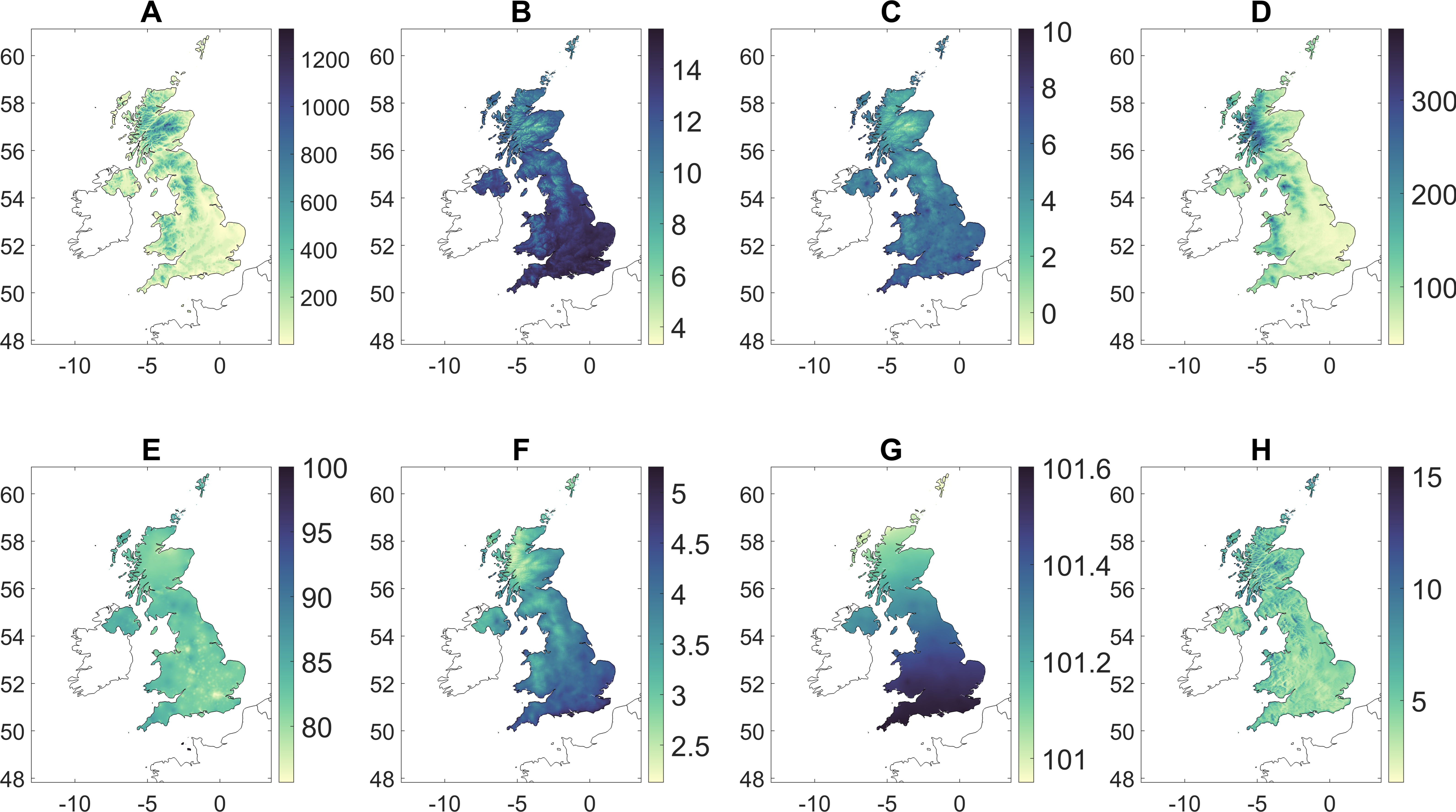
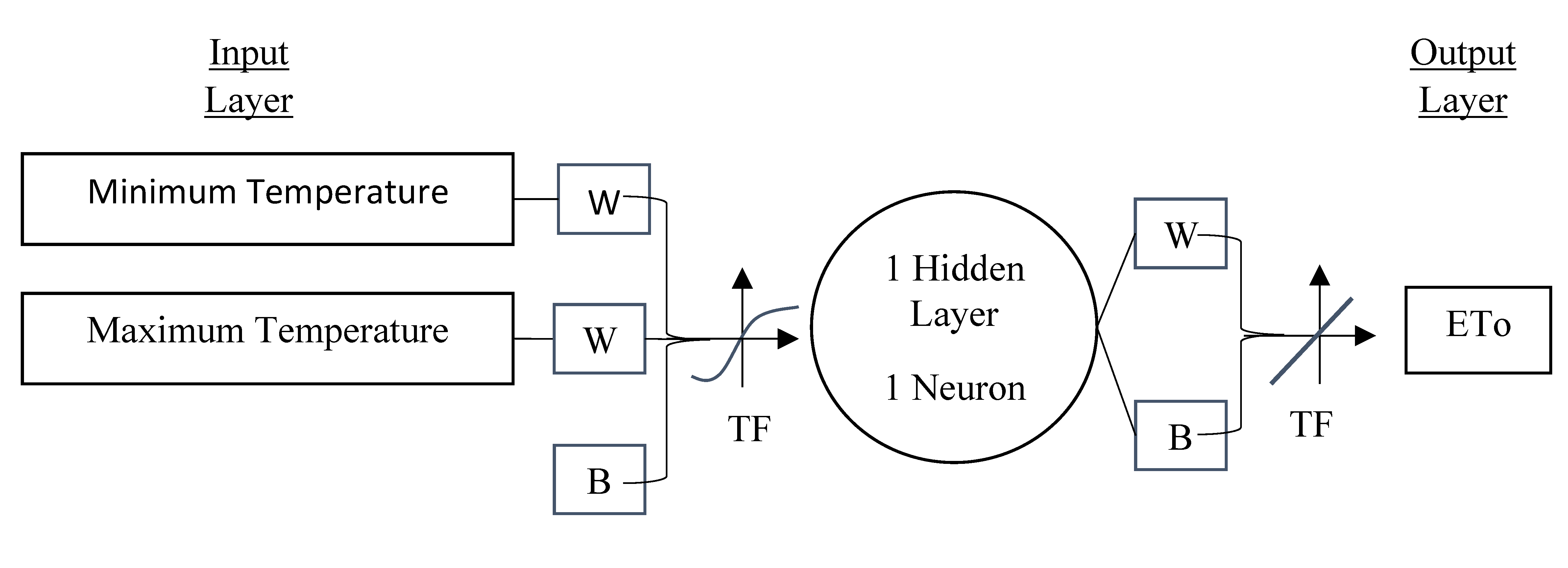


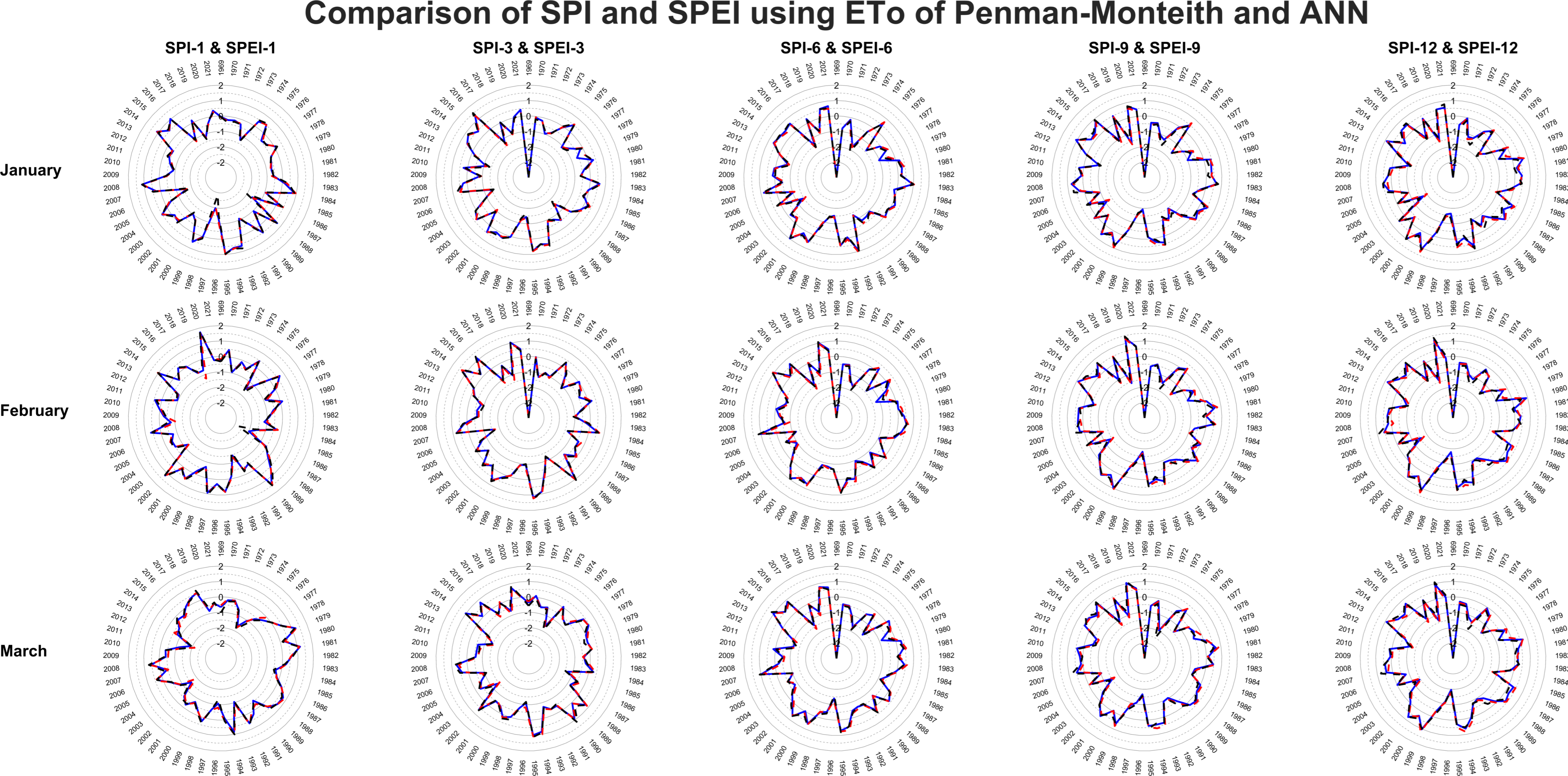

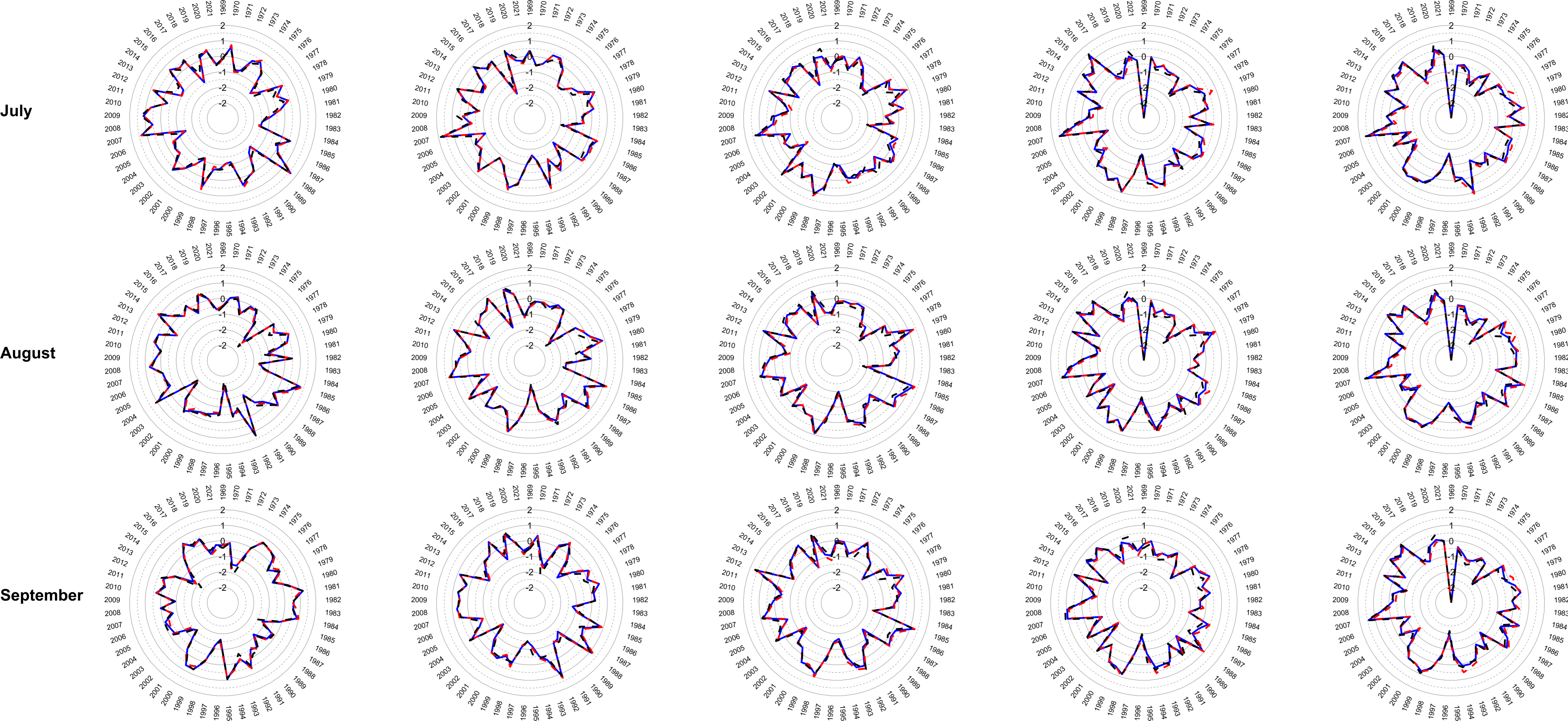
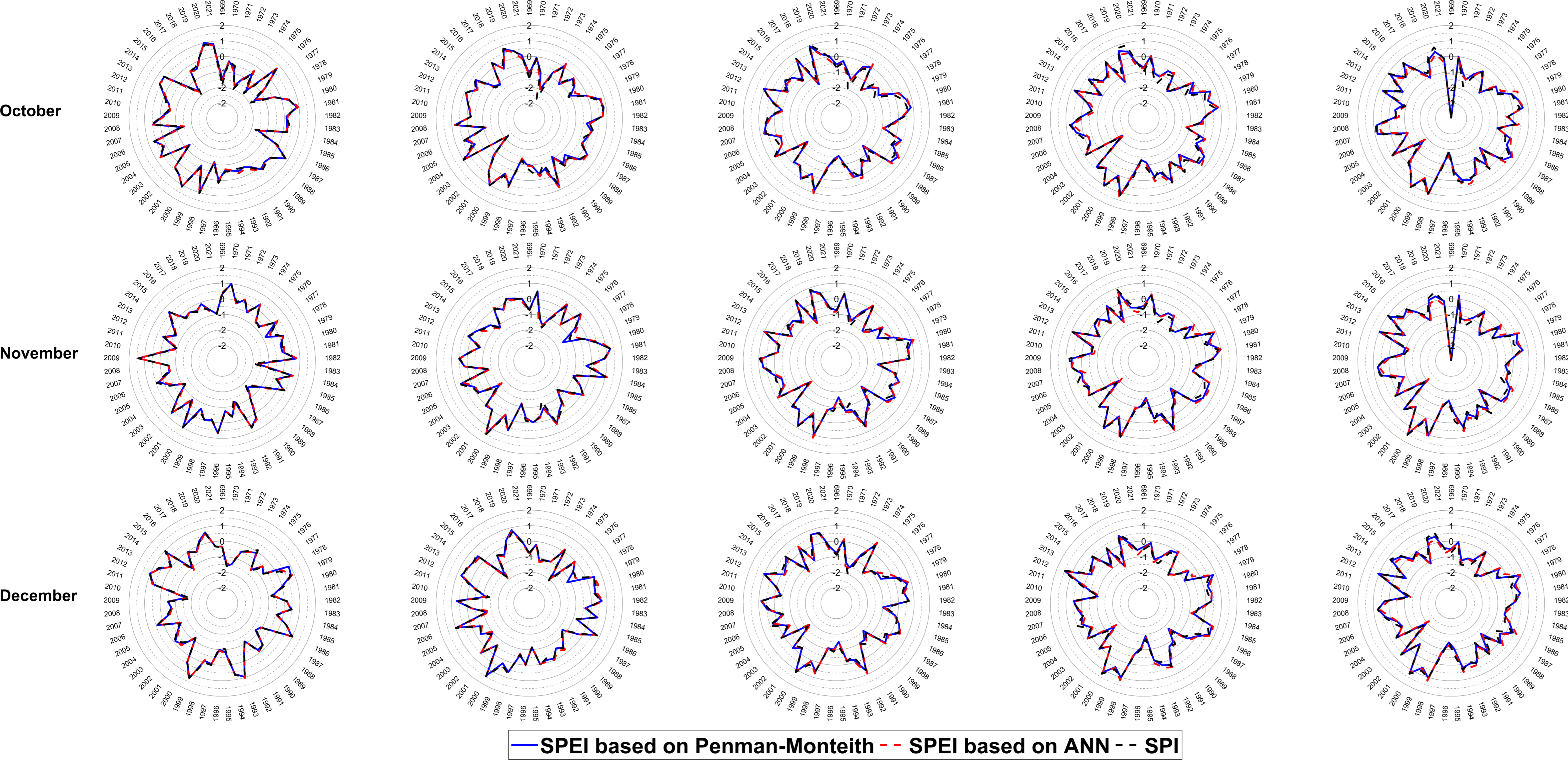
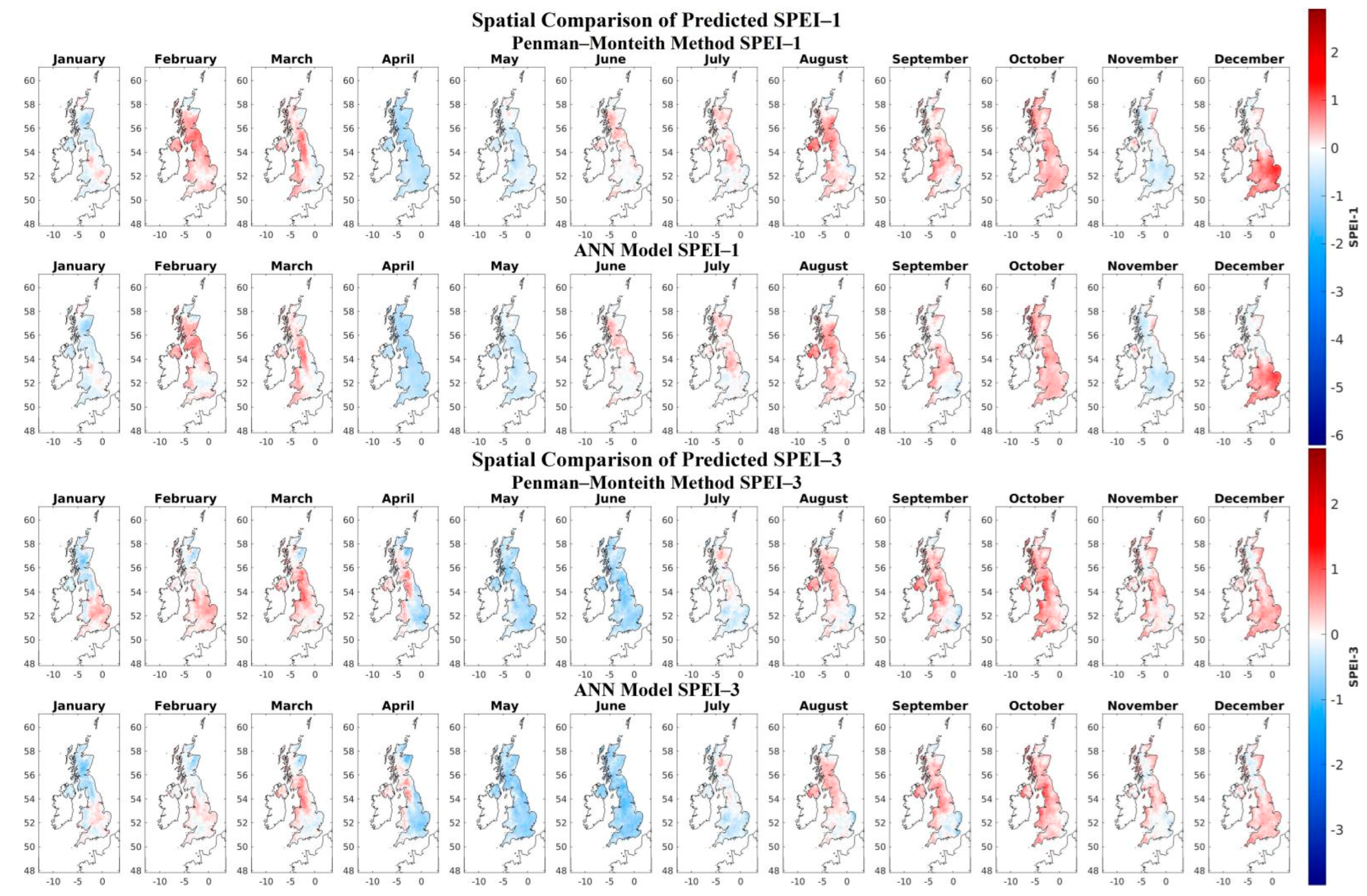
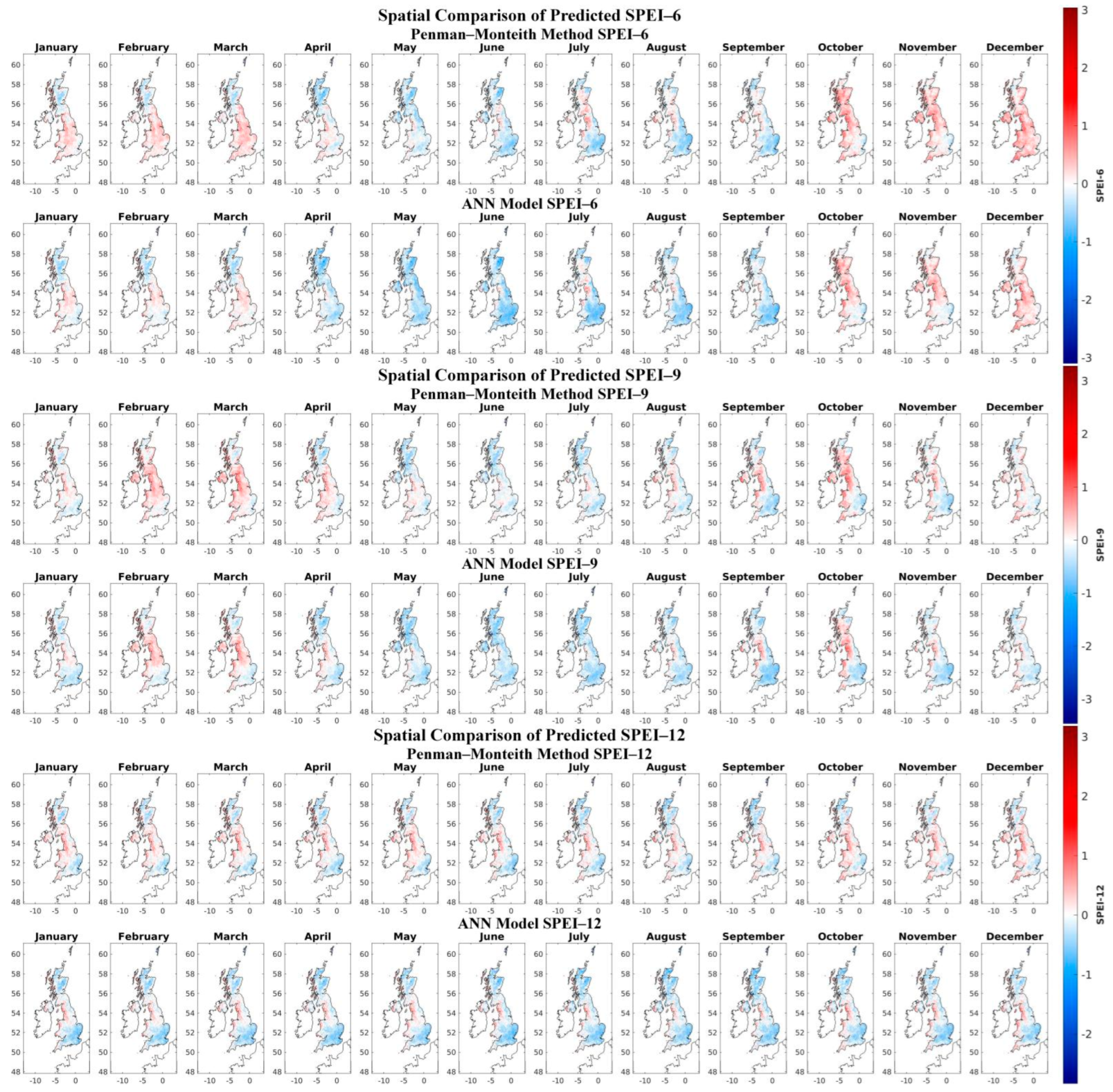
| Minimum | Maximum | Mean | Standard Deviation | Coefficient of Variation | |
|---|---|---|---|---|---|
| Maximum Temperature (°C) | |||||
| Training (1969–2011) | −6.21 | 28.28 | 12.51 | 0.13 | 0.01 |
| Validation (2012–2016) | −4.82 | 26.66 | 13.00 | 0.13 | 0.01 |
| Prediction (2017–2021) | −3.97 | 28.09 | 13.31 | 0.13 | 0.01 |
| Minimum Temperature (°C) | |||||
| Training (1969–2011) | −10.99 | 17.40 | 5.37 | 0.05 | 0.01 |
| Validation (2012–2016) | −8.06 | 16.43 | 5.74 | 0.05 | 0.01 |
| Prediction (2017–2021) | −7.14 | 17.19 | 6.00 | 0.05 | 0.01 |
Disclaimer/Publisher’s Note: The statements, opinions and data contained in all publications are solely those of the individual author(s) and contributor(s) and not of MDPI and/or the editor(s). MDPI and/or the editor(s) disclaim responsibility for any injury to people or property resulting from any ideas, methods, instructions or products referred to in the content. |
© 2022 by the authors. Licensee MDPI, Basel, Switzerland. This article is an open access article distributed under the terms and conditions of the Creative Commons Attribution (CC BY) license (https://creativecommons.org/licenses/by/4.0/).
Share and Cite
Doshi, S.C.; Shanmugam, M.S.; Akib, S. Assessment of Artificial Neural Network through Drought Indices. Eng 2023, 4, 31-46. https://doi.org/10.3390/eng4010003
Doshi SC, Shanmugam MS, Akib S. Assessment of Artificial Neural Network through Drought Indices. Eng. 2023; 4(1):31-46. https://doi.org/10.3390/eng4010003
Chicago/Turabian StyleDoshi, Smit Chetan, Mohana Sundaram Shanmugam, and Shatirah Akib. 2023. "Assessment of Artificial Neural Network through Drought Indices" Eng 4, no. 1: 31-46. https://doi.org/10.3390/eng4010003
APA StyleDoshi, S. C., Shanmugam, M. S., & Akib, S. (2023). Assessment of Artificial Neural Network through Drought Indices. Eng, 4(1), 31-46. https://doi.org/10.3390/eng4010003






